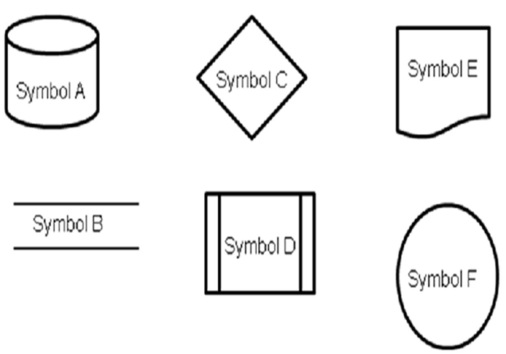Consider the following set of symbols and the ELM case as you respond to the question: ELM Corporation sells durable medical equipment, such as wheelchairs and hospital beds; each salesperson at ELM specializes in a specific type of medical equipment.When a prospective client comes into their store, a greeter does a preliminary needs assessment to determine what type(s) of equipment the client requires.Based on that preliminary assessment, the greeter will match the client with a member of the sales staff.The staff specialist does a more detailed needs assessment, the results of which go into a computerized database along with the client's name, address, phone number and other related information.After the needs assessment, the staff specialist determines the client's budget, as well as whether the client has insurance coverage for the desired equipment; clients without insurance coverage receive a 10% discount on all equipment purchased up to $1,000, and a 20% discount for any sales over $1,000.The staff specialist makes recommendations based on the client's needs and budget.If the client chooses to purchase from ELM, the store fills out any necessary insurance paperwork and collects the client's portion of the bill.For example, if an insured client purchases a wheelchair with a price of $2,000 and the insurance covers 80%, ELM collects $400 from the client at the time of the sale.ELM accepts cash, checks and major credit cards from clients.Insurance payments go directly to ELM's bank account and normally arrive within 60 days of the sale.If the client needs more than one type of durable medical equipment, the first staff specialist introduces the client to a subsequent staff specialist, who repeats the process until all the client's equipment needs are met.  In a systems flowchart of ELM's sales/collection process, "conduct preliminary needs assessment" would most likely be depicted with:
In a systems flowchart of ELM's sales/collection process, "conduct preliminary needs assessment" would most likely be depicted with:
Definitions:
Fair Value
The estimated market price of an asset or liability, reflecting the amount for which it could be exchanged or settled between knowledgeable parties in an arm's length transaction.
Book Value
This is the net value of a company's assets minus its liabilities, as recorded on the balance sheet.
FIFO Inventory Method
An inventory valuation method where the first items acquired are the first ones sold, used to determine the cost of goods sold and ending inventory.
Net Income
Net income is the total earnings of a company after subtracting all expenses, including taxes, costs, and losses, from its total revenue, indicating its profit.
Q5: Sales Cycle
Q11: Ethical egoism and deontology both teach that:<br>A)the
Q13: Consider the following flowchart symbols as necessary
Q18: CGI Corporation uses a process costing system
Q27: Knowledge:<br>A)Is an element of financial statements.<br>B)Should be
Q34: The PCAOB has:<br>A)Eliminated autonomy of practice in
Q43: Consider the following illustration as you respond
Q53: Match each risk exposure on the left
Q58: The CoBIT framework can be used to
Q60: Consider the following REA diagram as you